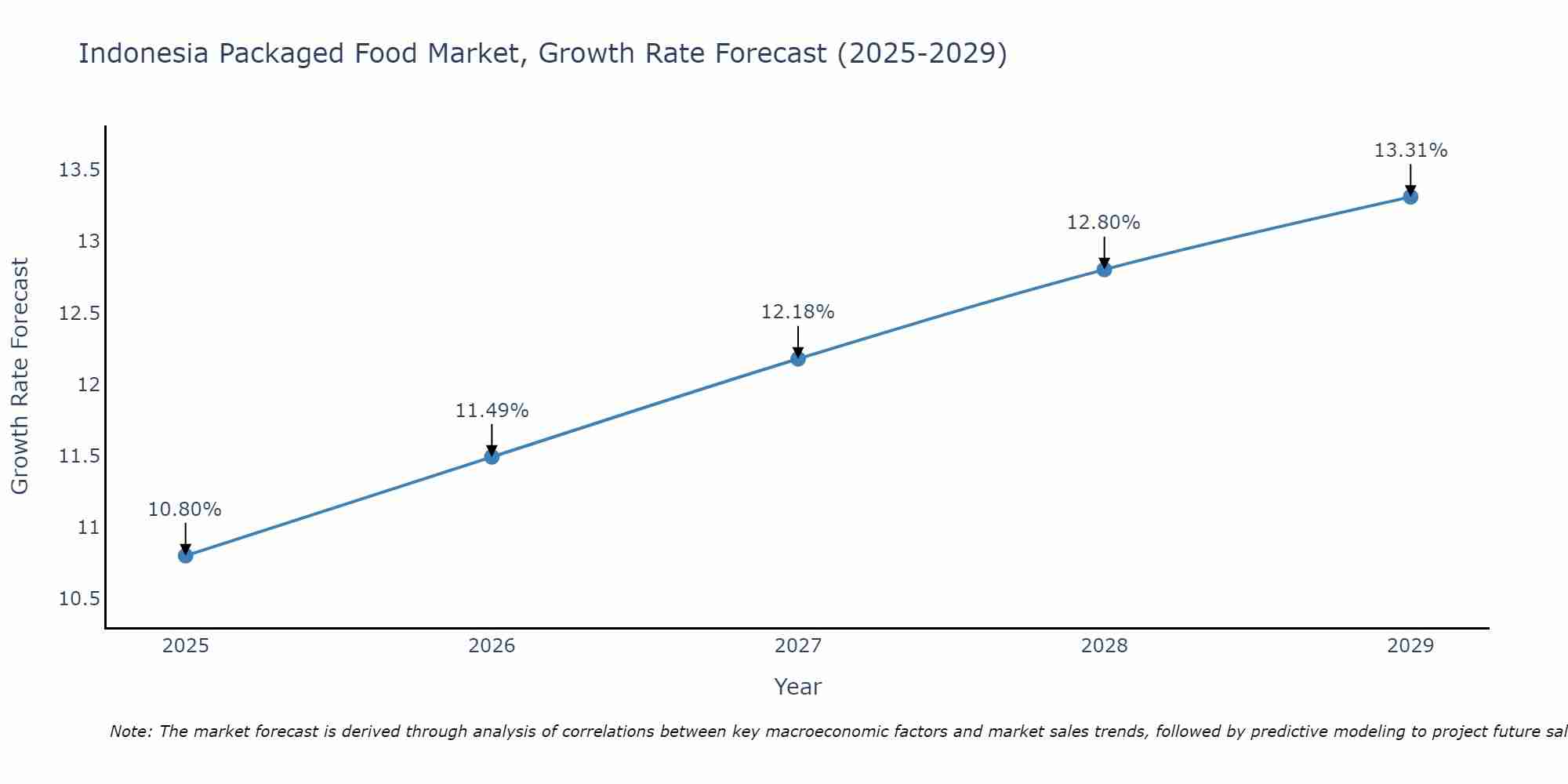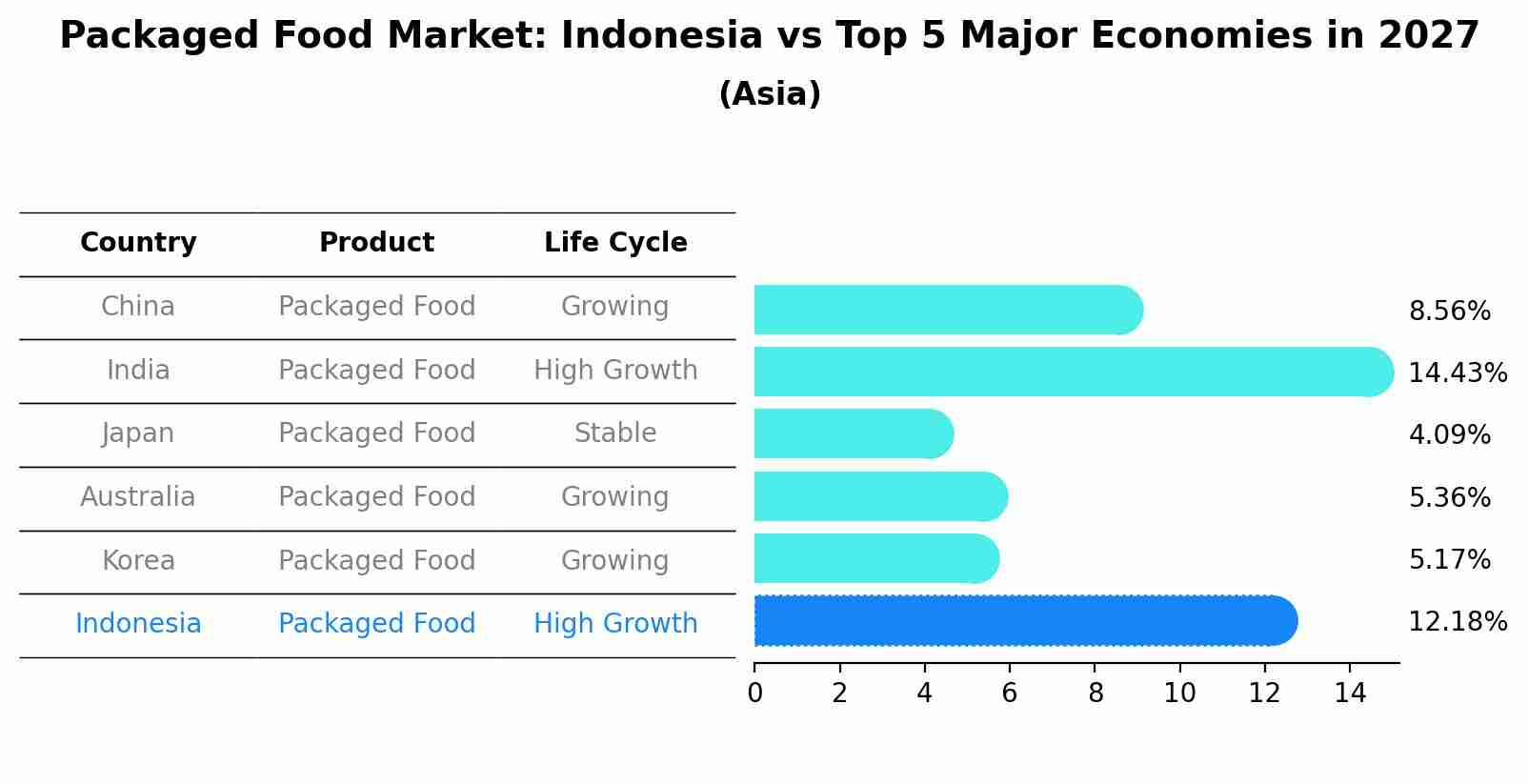Indonesia Packaged Food Market (2024-2030) | Size, Growth, Industry, Forecast, Revenue, Outlook, Companies, Share, Analysis, Trends & Value
| Product Code: ETC020088 | Publication Date: Jul 2023 | Updated Date: Aug 2025 | Product Type: Report | |
| Publisher: 6Wresearch | No. of Pages: 70 | No. of Figures: 35 | No. of Tables: 5 | |
Indonesia Packaged Food Market Size Growth Rate
The Indonesia Packaged Food Market is poised for steady growth rate improvements from 2025 to 2029. The growth rate starts at 10.80% in 2025 and reaches 13.31% by 2029.

Packaged Food Market: Indonesia vs Top 5 Major Economies in 2027 (Asia)
By 2027, the Packaged Food market in Indonesia is anticipated to reach a growth rate of 12.18%, as part of an increasingly competitive Asia region, where China remains at the forefront, supported by India, Japan, Australia and South Korea, driving innovations and market adoption across sectors.

Indonesia Packaged Food Market Synopsis
The Indonesia packaged food market is projected to grow at a higher CAGR during 2021-2026 (theperiod). Rising demand for processed products such as noodles ready meals snacks confectionery items have been driving theof this market. Moreover various initiatives taken by government related to nutritional regulations are expected to open new opportunities for manufacturers operating within the country`s boundaries. Additionally increasing presence of foreign players along with private label offerings are further likely to accelerate therate of thisover next five years.
Key Highlights of the Report:
- Indonesia Packaged Food Market Outlook
- Market Size of Indonesia Packaged Food Market, 2023
- Forecast of Indonesia Packaged Food Market, 2030
- Historical Data and Forecast of Indonesia Packaged Food Revenues & Volume for the Period 2020-2030
- Indonesia Packaged Food Market Trend Evolution
- Indonesia Packaged Food Market Drivers and Challenges
- Indonesia Packaged Food Price Trends
- Indonesia Packaged Food Porter's Five Forces
- Indonesia Packaged Food Industry Life Cycle
- Historical Data and Forecast of Indonesia Packaged Food Market Revenues & Volume By Product Type for the Period 2020-2030
- Historical Data and Forecast of Indonesia Packaged Food Market Revenues & Volume By Dairy Products for the Period 2020-2030
- Historical Data and Forecast of Indonesia Packaged Food Market Revenues & Volume By Bakery Products for the Period 2020-2030
- Historical Data and Forecast of Indonesia Packaged Food Market Revenues & Volume By Ready Meals for the Period 2020-2030
- Historical Data and Forecast of Indonesia Packaged Food Market Revenues & Volume By Confectionery for the Period 2020-2030
- Historical Data and Forecast of Indonesia Packaged Food Market Revenues & Volume By Breakfast Cereals for the Period 2020-2030
- Historical Data and Forecast of Indonesia Packaged Food Market Revenues & Volume By Baby Food for the Period 2020-2030
- Historical Data and Forecast of Indonesia Packaged Food Market Revenues & Volume By Non-alcoholic Beverages for the Period 2020-2030
- Historical Data and Forecast of Indonesia Dairy Products Packaged Food Market Revenues & Volume By Sauces, Condiments, and Dressings for the Period 2020-2030
- Historical Data and Forecast of Indonesia Packaged Food Market Revenues & Volume By Distribution Channel for the Period 2020-2030
- Historical Data and Forecast of Indonesia Packaged Food Market Revenues & Volume By Supermarket/Hypermarket for the Period 2020-2030
- Historical Data and Forecast of Indonesia Packaged Food Market Revenues & Volume By Convenience Stores for the Period 2020-2030
- Historical Data and Forecast of Indonesia Packaged Food Market Revenues & Volume By Retail Stores for the Period 2020-2030
- Historical Data and Forecast of Indonesia Packaged Food Market Revenues & Volume By E-commerce for the Period 2020-2030
- Indonesia Packaged Food Import Export Trade Statistics
- Market Opportunity Assessment By Product Type
- Market Opportunity Assessment By Distribution Channel
- Indonesia Packaged Food Top Companies Market Share
- Indonesia Packaged Food Competitive Benchmarking By Technical and Operational Parameters
- Indonesia Packaged Food Company Profiles
- Indonesia Packaged Food Key Strategic Recommendations
Frequently Asked Questions About the Market Study (FAQs):
1 Executive Summary |
2 Introduction |
2.1 Key Highlights of the Report |
2.2 Report Description |
2.3 Market Scope & Segmentation |
2.4 Research Methodology |
2.5 Assumptions |
3 Indonesia Packaged Food Market Overview |
3.1 Indonesia Country Macro Economic Indicators |
3.2 Indonesia Packaged Food Market Revenues & Volume, 2020 & 2030F |
3.3 Indonesia Packaged Food Market - Industry Life Cycle |
3.4 Indonesia Packaged Food Market - Porter's Five Forces |
3.5 Indonesia Packaged Food Market Revenues & Volume Share, By Product Type, 2020 & 2030F |
3.6 Indonesia Packaged Food Market Revenues & Volume Share, By Distribution Channel, 2020 & 2030F |
4 Indonesia Packaged Food Market Dynamics |
4.1 Impact Analysis |
4.2 Market Drivers |
4.2.1 Increasing urbanization and hectic lifestyles leading to higher demand for convenient and ready-to-eat packaged foods. |
4.2.2 Rising disposable incomes and changing consumer preferences towards healthier and premium packaged food products. |
4.2.3 Growing awareness about food safety and hygiene, driving consumers towards packaged foods over loose items. |
4.3 Market Restraints |
4.3.1 Price sensitivity among a significant portion of the population, limiting adoption of premium packaged food products. |
4.3.2 Concerns regarding the nutritional content and additives in packaged foods, leading to a preference for fresh and organic alternatives. |
4.3.3 Competition from traditional and street food vendors offering cheaper alternatives to packaged foods. |
5 Indonesia Packaged Food Market Trends |
6 Indonesia Packaged Food Market, By Types |
6.1 Indonesia Packaged Food Market, By Product Type |
6.1.1 Overview and Analysis |
6.1.2 Indonesia Packaged Food Market Revenues & Volume, By Product Type, 2020-2030F |
6.1.3 Indonesia Packaged Food Market Revenues & Volume, By Dairy Products, 2020-2030F |
6.1.4 Indonesia Packaged Food Market Revenues & Volume, By Bakery Products, 2020-2030F |
6.1.5 Indonesia Packaged Food Market Revenues & Volume, By Ready Meals, 2020-2030F |
6.1.6 Indonesia Packaged Food Market Revenues & Volume, By Confectionery, 2020-2030F |
6.1.7 Indonesia Packaged Food Market Revenues & Volume, By Breakfast Cereals, 2020-2030F |
6.1.8 Indonesia Packaged Food Market Revenues & Volume, By Baby Food, 2020-2030F |
6.1.9 Indonesia Packaged Food Market Revenues & Volume, By Sauces, Condiments, and Dressings, 2020-2030F |
6.1.10 Indonesia Packaged Food Market Revenues & Volume, By Sauces, Condiments, and Dressings, 2020-2030F |
6.2 Indonesia Packaged Food Market, By Distribution Channel |
6.2.1 Overview and Analysis |
6.2.2 Indonesia Packaged Food Market Revenues & Volume, By Supermarket/Hypermarket, 2020-2030F |
6.2.3 Indonesia Packaged Food Market Revenues & Volume, By Convenience Stores, 2020-2030F |
6.2.4 Indonesia Packaged Food Market Revenues & Volume, By Retail Stores, 2020-2030F |
6.2.5 Indonesia Packaged Food Market Revenues & Volume, By E-commerce, 2020-2030F |
7 Indonesia Packaged Food Market Import-Export Trade Statistics |
7.1 Indonesia Packaged Food Market Export to Major Countries |
7.2 Indonesia Packaged Food Market Imports from Major Countries |
8 Indonesia Packaged Food Market Key Performance Indicators |
8.1 Percentage increase in the sales of organic or health-oriented packaged food products. |
8.2 Growth in the market penetration of packaged food products in rural areas. |
8.3 Number of new product launches focusing on convenience and innovation in the packaged food segment. |
8.4 Consumer surveys indicating the level of trust and satisfaction with the quality and safety of packaged food products. |
8.5 Adoption rate of online grocery shopping for purchasing packaged food items. |
9 Indonesia Packaged Food Market - Opportunity Assessment |
9.1 Indonesia Packaged Food Market Opportunity Assessment, By Product Type, 2020 & 2030F |
9.2 Indonesia Packaged Food Market Opportunity Assessment, By Distribution Channel, 2020 & 2030F |
10 Indonesia Packaged Food Market - Competitive Landscape |
10.1 Indonesia Packaged Food Market Revenue Share, By Companies, 2023 |
10.2 Indonesia Packaged Food Market Competitive Benchmarking, By Operating and Technical Parameters |
11 Company Profiles |
12 Recommendations |
13 Disclaimer |
- Single User License$ 1,995
- Department License$ 2,400
- Site License$ 3,120
- Global License$ 3,795
Search
Related Reports
- UAE Building Thermal Insulation Market Outlook (2025-2031) | Revenue, Companies, Share, Trends, Growth, Size, Forecast, Industry, Analysis & Value
- Portugal Electronic Document Management Market (2025-2031) | Strategy, Consumer Insights, Analysis, Investment Trends, Opportunities, Growth, Size, Share, Industry, Revenue, Segments, Value, Segmentation, Supply, Forecast, Restraints, Outlook, Competition, Drivers, Trends, Demand, Pricing Analysis, Competitive, Strategic Insights, Companies, Challenges
- France Electronic Document Management Market (2025-2031) | Strategy, Consumer Insights, Analysis, Investment Trends, Opportunities, Growth, Size, Share, Industry, Revenue, Segments, Value, Segmentation, Supply, Forecast, Restraints, Outlook, Competition, Drivers, Trends, Demand, Pricing Analysis, Competitive, Strategic Insights, Companies, Challenges
- Portugal Occupational Health & Safety Services Market (2025-2031) | Strategy, Consumer Insights, Analysis, Investment Trends, Opportunities, Growth, Size, Share, Industry, Revenue, Segments, Value, Segmentation, Supply, Forecast, Restraints, Outlook, Competition, Drivers, Trends, Demand, Pricing Analysis, Competitive, Strategic Insights, Companies, Challenges
- Netherlands Occupational Health and Safety Services Market (2025-2031) | Strategy, Consumer Insights, Analysis, Investment Trends, Opportunities, Growth, Size, Share, Industry, Revenue, Segments, Value, Segmentation, Supply, Forecast, Restraints, Outlook, Competition, Drivers, Trends, Demand, Pricing Analysis, Competitive, Strategic Insights, Companies, Challenges
- Belgium and Luxembourg Facility Management Market (2025-2031) | Strategy, Consumer Insights, Analysis, Investment Trends, Opportunities, Growth, Size, Share, Industry, Revenue, Segments, Value, Segmentation, Supply, Forecast, Restraints, Outlook, Competition, Drivers, Trends, Demand, Pricing Analysis, Competitive, Strategic Insights, Companies, Challenges
- Russia Women Intimate Apparel Market (2025-2031) | Strategy, Consumer Insights, Analysis, Investment Trends, Opportunities, Growth, Size, Share, Industry, Revenue, Segments, Value, Segmentation, Supply, Forecast, Restraints, Outlook, Competition, Drivers, Trends, Demand, Pricing Analysis, Competitive, Strategic Insights, Companies, Challenges
- Africa Chocolate Market (2025-2031) | Size, Share, Trends, Growth, Revenue, Analysis, Forecast, industry & Outlook
- Global Hydroxychloroquine And Chloroquine Market (2025-2031) | Industry, Trends, Size, Outlook, Growth, Value, Companies, Revenue, Analysis, Share, Forecast
- Saudi Arabia Plant Maintenance Market (2025-2031) | Industry, Size, Growth, Revenue, Value, Companies, Forecast, Analysis, Share & Trends
Industry Events and Analyst Meet
Our Clients
Whitepaper
- Middle East & Africa Commercial Security Market Click here to view more.
- Middle East & Africa Fire Safety Systems & Equipment Market Click here to view more.
- GCC Drone Market Click here to view more.
- Middle East Lighting Fixture Market Click here to view more.
- GCC Physical & Perimeter Security Market Click here to view more.
6WResearch In News
- Doha a strategic location for EV manufacturing hub: IPA Qatar
- Demand for luxury TVs surging in the GCC, says Samsung
- Empowering Growth: The Thriving Journey of Bangladesh’s Cable Industry
- Demand for luxury TVs surging in the GCC, says Samsung
- Video call with a traditional healer? Once unthinkable, it’s now common in South Africa
- Intelligent Buildings To Smooth GCC’s Path To Net Zero













